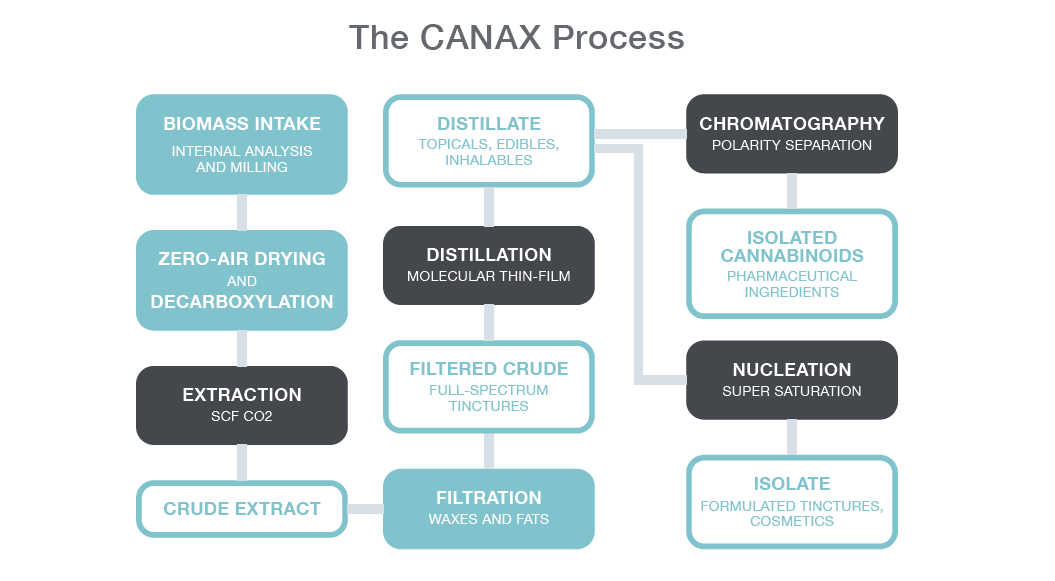CO2 extraction
Supercritical
Processing and
Purification
Micronization and
Nanotization
The principle used in those processes is the powders micronic grinding by super high speed mechanical impact and crystallization of the compounds by fast drying due to the (CO2) expansion.
Analysis and
Quality control
Through this analyses it is possible to validate and certify the quality of the processing and purification procedures.
Recycling
Waste
The recirculated products obtained from our processes are materials derived from the biomass with no contaminants, since we use clean technologies.
Therefore, the exhausted biomass, after the extraction, can be used as “light” flour with high protein contents, and some recirculated plant waxes, chlorophyl and pigments can be used in the cosmetic industry.
Product
Finished
The range of finished products includes dietary supplements, high-end cosmeceuticals and beauty products, nutraceuticals etc.
Processing goal
The Cannabis sativa (industrial hemp) processing focus is the separation of noble compounds, containing cannabinoids from the biomass. In this process, the biomass is first dried and resized by grinding.
The minimal size of the biomass particles (> 1 mm) leads to the maximization of the surface contact between the biomass and the process fluid which will solubilize the compounds. In our case the process fluid is the supercritical CO2 (pressure > 72 atm. and temperature > 32°C).
- Procedure
- Purification and concentration
- Micronization and nanotization
- Analysis and quality control
- Recycling of the waste
Procedure
Our technology consists in applying high pressure directly to the CO2 (process fluid) to induce the critical state, obtaining, in this intermediate phase between liquid and gas state (pressure > 72 atm. and temperature > 32°C), an absolutely non-toxic solvent.
The fluid (CO2) is continuously recirculated within the process, starting from when it becomes a gas and is released from the raw material. The application is therefore environmentally-friendly: in the gas state, CO2 is an inert, non-toxic and non-flammable gas, and does not leave any trace in the extract and in the environment.
Purification and concentration
By modifying the density of the process fluid with pressure, four different extract fractions can be obtained in the various separation stages, based on the molecular weight of the compounds to be separated. The extracts can therefore be isolated from the unwanted compounds (ex. plant waxes, chlorophyl etc.) and concentrated in the desired compounds already in the extraction step.
Other applications after the extraction step, like chromatography, allow to obtain a high concentration of the extracted active compounds
Micronization and nanotization
Using traditional procedures (jet milling) and more advanced technologies (supercritical CO2 micronization and nanonization) it is possible to obtain medical and/or active substance powders in the micrometers (thousandths of a millimeter) range. The liquid extracts are dewatered by spray drying to nebulize and dry extracts and liquid suspensions.
The material to be dried enters in a high-pressure liquid form in a dispenser reactor equipped with outlets (nebulization lances/nozzles). Due to the pressure and the cold generated by the gas expansion, the liquid exits from the nozzles as nebulized droplets. The solid part resulting from the removal of the nebulized fluid consists therefore of active substance powders. This powder fraction falls to the reactor’s bottom while the droplets stay on the reactor’s walls.
Analysis and quality control
The analysis department, key in the several quality control steps, uses various equipment (HPLC, LC/MS, GC/MS, ICP/MS) to identify the compounds present in the different processing steps, and verify the biomass quality.
This system checks the quality of the raw material and validated the processing/purification procedures. Finally, the quality and standards of the finished product are checked.
Recycling of the waste for use as secondary material
One of the main processing goals is the use of the industrial transformation of production waste in “secondary” materials in other areas using clean technologies.
The products, which can be recirculated by the processing and be used as secondary materials are, in our case, fully organic materials with no contaminants, due to the processing quality. The exhausted biomass can be used as “light” flour with high protein contents. Plant waxes and fats, chlorophyl and raw materials can be used in the cosmetic industry as raw materials.
The plant
The extraction/processing plant includes the following departments:
- Raw material (biomass), receipt, cataloging and storage
- Raw extraction (supercritical co2 extractors)
- Extracts processing for nutraceutical use
- Extracts processing for pharmaceutical use (GMP)
- Analysis and quality control
- Research and development
- Finished products formulation and production
Supercritical CO2 extraction is an important separation procedure used in the food, nutraceutical, and pharmaceutical industries, which isolates active principles by applying high pressure to the material to be extracted in presence of gas, primarily CO2.
Extraction with supercritical fluids is a Green Technology ensuring the process environmental sustainability and a high degree of quality and purity of the extracted product.
It is a clean, selective technology not requiring high temperatures and representing an alternative to the ordinary extraction with organic solvents, highly toxic for the environment and humans.


